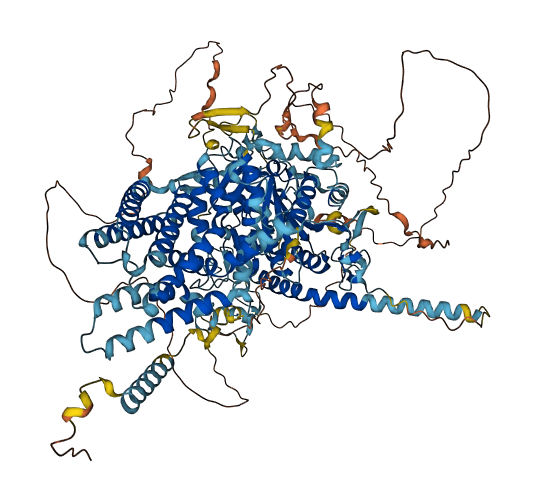- Information
- Symbol: OsCD1,OsCSLD4,NRL1,ND1,sle1,DNL1
- MSU: LOC_Os12g36890
- RAPdb: Os12g0555600
- PSP score
- LOC_Os12g36890.1: 0.3368
- PLAAC score
- LOC_Os12g36890.1: 0
- pLDDT score
- 71.29
- Protein Structure from AlphaFold and UniProt
- MolPhase score
- LOC_Os12g36890.1: 0.98809248
- MolPhase Result
- Publication
- Rice slender leaf 1 gene encodes cellulose synthase-like D4 and is specifically expressed in M-phase cells to regulate cell proliferation, 2013, J Exp Bot.
- Rice cellulose synthase-like D4 is essential for normal cell-wall biosynthesis and plant growth, 2009, Plant J.
- OsCD1 encodes a putative member of the cellulose synthase-like D sub-family and is essential for rice plant architecture and growth, 2011, Plant Biotechnol J.
- Rice plants response to the disruption of OsCSLD4 gene, 2010, Plant Signal Behav.
- Isolation and characterization of a rice mutant with narrow and rolled leaves, 2010, Planta.
- Identification and characterization of NARROW AND ROLLED LEAF 1, a novel gene regulating leaf morphology and plant architecture in rice, 2010, Plant Mol Biol.
- DNL1, encodes cellulose synthase-like D4, is a major QTL for plant height and leaf width in rice Oryza sativa L.., 2014, Biochem Biophys Res Commun.
- Genbank accession number
- Key message
- Double-target in situ hybridization and quantitative RT-PCR analyses revealed that SLE1 was expressed specifically during the M-phase of the cell cycle, and suggested that the cell-cycle regulation was altered in sle1 mutants
- Analysis of OsCD1 promoter with GUS fusion expression shows that OsCD1 exhibits higher expression in young meristem tissues such as fresh roots, young panicle and stem apical meristem
- To understand the molecular mechanism of leaf morphogenesis, we identified a rice mutant nrl1, which was characterized by a phenotype of narrow and rolled leaves
- We isolated three allelic mutants of NARROW AND ROLLED LEAF 1 (nrl1) which showed phenotypes of reduced leaf width and semi-rolled leaves and different degrees of dwarfism
- The NRL1 gene was mapped to the chromosome 12 and encodes the cellulose synthase-like protein D4 (OsCslD4)
- We conclude that OsCslD4 encoded by NRL1 plays a critical role in leaf morphogenesis and vegetative development in rice
- Cell wall composition analysis reveals that cellulose content and the level of xylose are significantly reduced in mature culm owing to loss of OsCD1 function
- We report here an in-depth characterization of a narrow leaf and dwarf1 (nd1) rice mutant that shows significant reduction in plant growth due to retarded cell division
- Map-based cloning revealed that SLE1 encodes the OsCSLD4 protein, which was identified previously from a narrow leaf and dwarf 1 mutant
- Immunological studies and monosaccharide compositional and glycosyl linkage analyses explored several wall compositional effects caused by disruption of OsCSLD4, including alterations in the structure of arabinoxylan and the content of cellulose and homogalacturonan, which are distinct in the monocot grass species Oryza sativa (rice)
- The nrl1 mutation was rescued by transformation with the wild-type cellulose synthase-like D4 gene
- Accordingly, the cellulose synthase-like D4 gene was identified as the NRL1 gene
- In addition to the size reduction of organs, sle1 mutants exhibited serious developmental defects in pollen formation, anther dehiscence, stomata formation, and cell arrangement in various tissues
- OsCD1 encodes a putative member of the cellulose synthase-like D sub-family and is essential for rice plant architecture and growth
- This study presents a detailed analysis of slender leaf 1 (sle1) mutants of rice that showed rolled and narrow leaf blades and a reduction in plant height
- The narrow leaf blade of sle1 was caused by reduced cell proliferation beginning at the P3 primordial stage
- Map-based cloning indicates that a member of the cellulose synthase-like D (CSLD) group is a candidate for OsCD1
- Furthermore, sequence analysis indicates that OsCD1 contains the common D,D,D,QXXRW motif, which is a feature of the cellulose synthase-like super-family
- OsCSLD4 is mainly expressed in tissues undergoing rapid growth
- The inconsistent alterations in the two tissues and the observable structural defects in primary walls indicate that OsCSLD4 plays important roles in cell-wall formation and plant growth
- NRL1 was transcribed in various tissues and was mainly expressed in panicles and internodes
- Further study of OsCSLD4 is expected to yield new insight into the role of hemicelluloses in plant development
- 08% phenotypic variation for plant height and leaf width, respectively, were located on the same interval of chromosome 12 flanking SSR markers RM519 and RM1103, and was named DNL1 (Dwarf and Narrowed Leaf 1)
- The results of ORF analysis in target region and nucleotide sequence alignment indicated that DNL1 encodes cellulose synthase-like D4 protein, and a single nucleotide substitution (C2488T) in dnl1 result in decrease in plant height and leaf width
- Connection
- OsCD1~OsCSLD4~NRL1~ND1~sle1~DNL1, RL9~SLL1, Isolation and characterization of a rice mutant with narrow and rolled leaves, NAL7 and SLL1 were found to be upregulated, whereas OsAGO7 were downregulated in the nrl1 mutant
- OsAGO7~shl4~SHO2, OsCD1~OsCSLD4~NRL1~ND1~sle1~DNL1, Isolation and characterization of a rice mutant with narrow and rolled leaves, NAL7 and SLL1 were found to be upregulated, whereas OsAGO7 were downregulated in the nrl1 mutant
Prev Next

